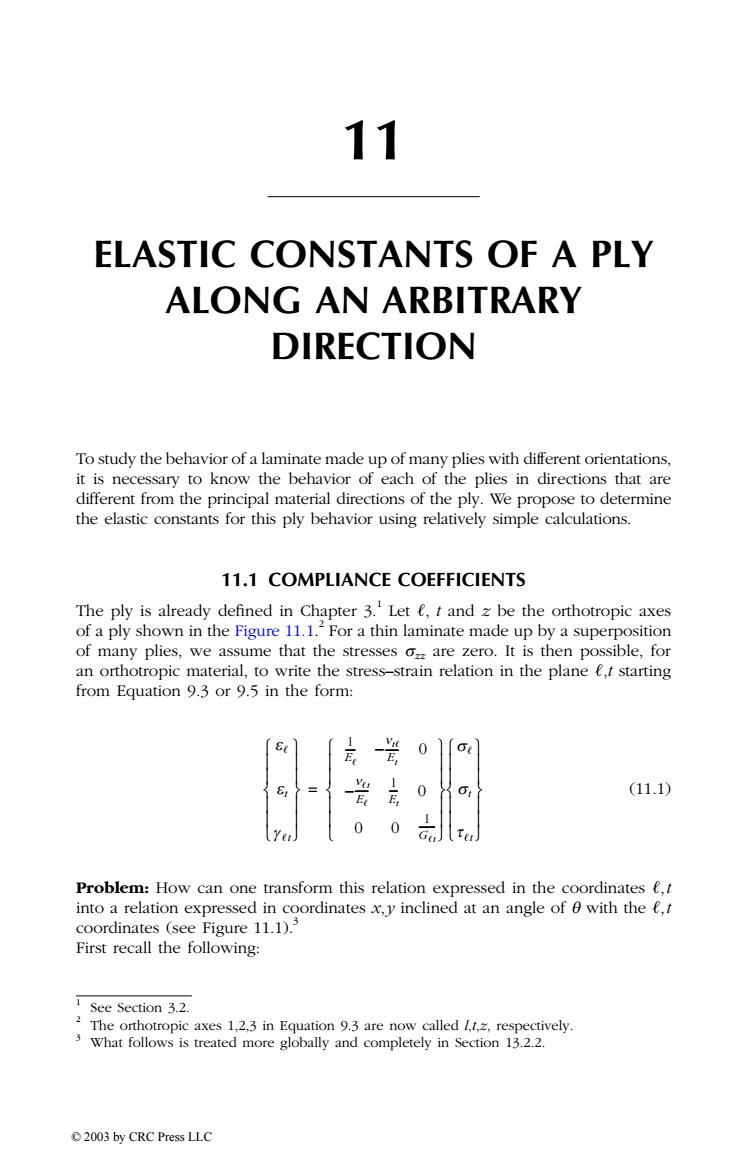正在加载图片...

11 ELASTIC CONSTANTS OF A PLY ALONG AN ARBITRARY DIRECTION To study the behavior of a laminate made up of many plies with different orientations, it is necessary to know the behavior of each of the plies in directions that are different from the principal material directions of the ply.We propose to determine the elastic constants for this ply behavior using relatively simple calculations. 11.1 COMPLIANCE COEFFICIENTS The ply is already defined in Chapter 3.Let e,t and zbe the orthotropic axes of a ply shown in the Figure 11.1.For a thin laminate made up by a superposition of many plies,we assume that the stresses o are zero.It is then possible,for an orthotropic material,to write the stress-strain relation in the plane t,t starting from Equation 9.3 or 9.5 in the form: V E 飞列 (11.1) E E 0 6 0 0 Gu Problem:How can one transform this relation expressed in the coordinates t,t into a relation expressed in coordinates x,y inclined at an angle of 0 with the e,t coordinates (see Figure 11.1).3 First recall the following: 1 See Section 3.2. 2 The orthotropic axes 1.2.3 in Equation 9.3 are now called respectively. 3 What follows is treated more globally and completely in Section 13.2.2. 2003 by CRC Press LLC11 ELASTIC CONSTANTS OF A PLY ALONG AN ARBITRARY DIRECTION To study the behavior of a laminate made up of many plies with different orientations, it is necessary to know the behavior of each of the plies in directions that are different from the principal material directions of the ply. We propose to determine the elastic constants for this ply behavior using relatively simple calculations. 11.1 COMPLIANCE COEFFICIENTS The ply is already defined in Chapter 3. 1 Let , t and z be the orthotropic axes of a ply shown in the Figure 11.1. 2 For a thin laminate made up by a superposition of many plies, we assume that the stresses szz are zero. It is then possible, for an orthotropic material, to write the stress–strain relation in the plane ,t starting from Equation 9.3 or 9.5 in the form: (11.1) Problem: How can one transform this relation expressed in the coordinates ,t into a relation expressed in coordinates x,y inclined at an angle of q with the ,t coordinates (see Figure 11.1).3 First recall the following: 1 See Section 3.2. 2 The orthotropic axes 1,2,3 in Equation 9.3 are now called l,t,z, respectively. 3 What follows is treated more globally and completely in Section 13.2.2. e et Óg t˛ Ô Ô Ô Ô Ì ˝ Ô Ô Ô Ô Ï ¸ l E ----- nt Et –------ 0 nt E ------ l Et – ---- 0 0 0 l Gt ------- Ó ˛ Ô Ô Ô Ô Ì ˝ Ô Ô Ô Ô Ï ¸ s st Ót t˛ Ô Ô Ô Ô Ì ˝ Ô Ô Ô Ô Ï ¸ = TX846_Frame_C11 Page 223 Monday, November 18, 2002 12:26 PM © 2003 by CRC Press LLC